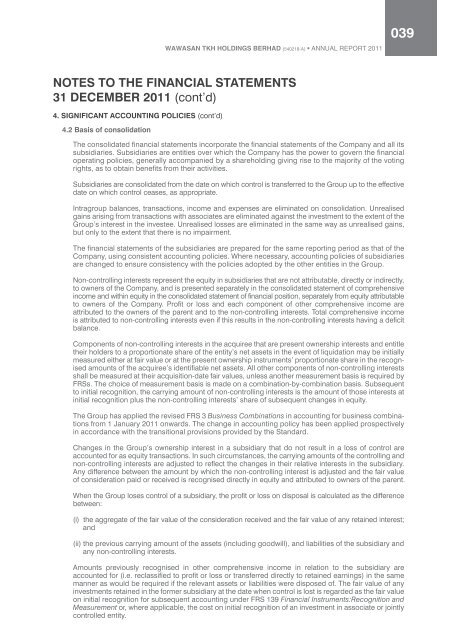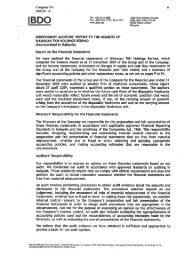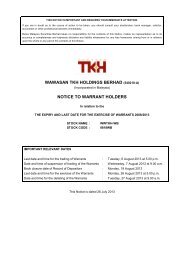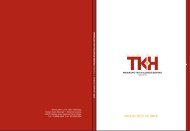Annual Report 2011 (Part I) - Wawasan TKH Holdings Berhad
Annual Report 2011 (Part I) - Wawasan TKH Holdings Berhad
Annual Report 2011 (Part I) - Wawasan TKH Holdings Berhad
Create successful ePaper yourself
Turn your PDF publications into a flip-book with our unique Google optimized e-Paper software.
WAWASAN <strong>TKH</strong> HOLDINGS BERHAD (540218-A) • ANNUAL REPORT <strong>2011</strong><br />
039<br />
NOTES TO THE FINANCIAL STATEMENTS<br />
31 DECEMBER <strong>2011</strong> (cont’d)<br />
4. SIGNIFICANT ACCOUNTING POLICIES (cont’d)<br />
4.2 Basis of consolidation<br />
The consolidated financial statements incorporate the financial statements of the Company and all its<br />
subsidiaries. Subsidiaries are entities over which the Company has the power to govern the financial<br />
operating policies, generally accompanied by a shareholding giving rise to the majority of the voting<br />
rights, as to obtain benefits from their activities.<br />
Subsidiaries are consolidated from the date on which control is transferred to the Group up to the effective<br />
date on which control ceases, as appropriate.<br />
Intragroup balances, transactions, income and expenses are eliminated on consolidation. Unrealised<br />
gains arising from transactions with associates are eliminated against the investment to the extent of the<br />
Group’s interest in the investee. Unrealised losses are eliminated in the same way as unrealised gains,<br />
but only to the extent that there is no impairment.<br />
The financial statements of the subsidiaries are prepared for the same reporting period as that of the<br />
Company, using consistent accounting policies. Where necessary, accounting policies of subsidiaries<br />
are changed to ensure consistency with the policies adopted by the other entities in the Group.<br />
Non-controlling interests represent the equity in subsidiaries that are not attributable, directly or indirectly,<br />
to owners of the Company, and is presented separately in the consolidated statement of comprehensive<br />
income and within equity in the consolidated statement of financial position, separately from equity attributable<br />
to owners of the Company. Profit or loss and each component of other comprehensive income are<br />
attributed to the owners of the parent and to the non-controlling interests. Total comprehensive income<br />
is attributed to non-controlling interests even if this results in the non-controlling interests having a deficit<br />
balance.<br />
Components of non-controlling interests in the acquiree that are present ownership interests and entitle<br />
their holders to a proportionate share of the entity’s net assets in the event of liquidation may be initially<br />
measured either at fair value or at the present ownership instruments’ proportionate share in the recognised<br />
amounts of the acquiree’s identifiable net assets. All other components of non-controlling interests<br />
shall be measured at their acquisition-date fair values, unless another measurement basis is required by<br />
FRSs. The choice of measurement basis is made on a combination-by-combination basis. Subsequent<br />
to initial recognition, the carrying amount of non-controlling interests is the amount of those interests at<br />
initial recognition plus the non-controlling interests’ share of subsequent changes in equity.<br />
The Group has applied the revised FRS 3 Business Combinations in accounting for business combinations<br />
from 1 January <strong>2011</strong> onwards. The change in accounting policy has been applied prospectively<br />
in accordance with the transitional provisions provided by the Standard.<br />
Changes in the Group’s ownership interest in a subsidiary that do not result in a loss of control are<br />
accounted for as equity transactions. In such circumstances, the carrying amounts of the controlling and<br />
non-controlling interests are adjusted to reflect the changes in their relative interests in the subsidiary.<br />
Any difference between the amount by which the non-controlling interest is adjusted and the fair value<br />
of consideration paid or received is recognised directly in equity and attributed to owners of the parent.<br />
When the Group loses control of a subsidiary, the profit or loss on disposal is calculated as the difference<br />
between:<br />
(i) the aggregate of the fair value of the consideration received and the fair value of any retained interest;<br />
and<br />
(ii) the previous carrying amount of the assets (including goodwill), and liabilities of the subsidiary and<br />
any non-controlling interests.<br />
Amounts previously recognised in other comprehensive income in relation to the subsidiary are<br />
accounted for (i.e. reclassified to profit or loss or transferred directly to retained earnings) in the same<br />
manner as would be required if the relevant assets or liabilities were disposed of. The fair value of any<br />
investments retained in the former subsidiary at the date when control is lost is regarded as the fair value<br />
on initial recognition for subsequent accounting under FRS 139 Financial Instruments:Recognition and<br />
Measurement or, where applicable, the cost on initial recognition of an investment in associate or jointly<br />
controlled entity.







